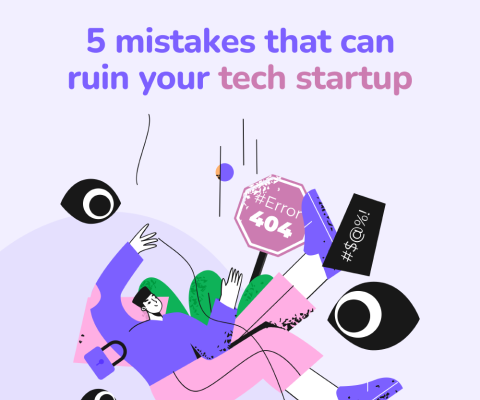December 17th, 2025, posted in for_founders
by Adelina
You’re starting off a new business, just getting it off the ground and still working on its concept. You want to develop either a web app or mobile app, and you know what it should do, what goals it’s supposed to fulfill, but you have no idea what it’s going to look like.
Businesses need branding: branding makes you stand out, it makes you recognizable and sets the tone for what your business does. It makes it easier for people to remember you especially if it’s something unique, that’s clearly your business.
Branding defines what your business stands for and what you actually do through simple visuals. Once you’ve set up your visual identity, you can head into creating multiple products that very clearly belong to the same suite. This saves time down the road in terms of UI/UX and frontend development, as the designers you hire can use your existing branding to create design systems.
So in this article, we’re going to explain why visual branding is important for your software and why you should build software with this element already in place.
What is visual branding?
Visual branding puts together the visual identity of a company or brand: logo, colors, specific fonts, icons and/or illustrations. These elements are made to go together and to form visual content that defines a particular company. Put simply, the fonts and icons or logo marks will be made to go well together.
When launching a new business, having at least a logo is very important - this makes it clear your business has ground to stand on, is a registered company and not just a concept you’re still thinking about, and it’s ready to launch something people can use. Especially if you’re starting off with software - your app will need a logo, unless you’re cool with just a random icon your designer picks. But do you really want that?
You might be familiar with a lot of big companies’ branding without even thinking too much about it: the classic M McDonald’s logo and their shades of green and yellow which symbolize greens and burger buns, Apple’s minimalist bitten apple logo, or Google’s colorful logos kept consistent across their suite of apps. When you see visual elements made by these companies, you just know it’s them.
What visual branding does is setting your voice, making you recognizable and giving visual hints at what you actually do. Sleek logos and fonts & shades of gray go great with serious businesses in the financial industry, while colorful, illustrated logos and thick fonts with rounded corners go great with entertainment or travel apps.

Source: Svetlana Kolpakova on Dribbble. This is a good example of sleek branding for a banking app. It’s not too punchy and colorful as we’re dealing with something more serious.
With visual branding, you get to make it clear who your audience is. The more sleek and colorless, the more serious your audience is. Bright colors and fun animations don’t go too well with corporate-type companies. But if you’re dealing with a young audience, fun visuals, funky designs and pretty colors makes it very clear you’re targeting them correctly. In other words, a big part of creating your visual identity is knowing what your audience is - and making sure it’s pretty specific.
So what can you include in a visual branding pack?
- Your logo. First and foremost, your logo is your company’s identifier. It’s the first thing, besides your company’s name, that people will notice. It defines who you are as a business and it makes you recognizable. Your logo should express your tone of voice, so the happier your concept is, the more colorful your logo will be, and the more serious the concept, the more sleek and colorless your logo should be.
- A few colors that define your brand. Your logo and brand colors can be made at the same time or one derived from the other. Call it a bit of a “chicken or egg first” type of situation. The colors you pick define your tone of voice the best out of everything in your visual branding. To best find your color palette, we recommend watching a few videos about color theory. For a quick summary, shades of orange, green and yellow work for energetic apps, blue is a universal color that works great for both serious and less serious apps, pink is a fun, relaxing color, purple is sleek and black & white are very universal and work best with corporate-themed apps. How many brand colors do you need? We’d say that a primary color, a secondary color that matches the primary one and a neutral color (such as a dark navy, dark gray) that can be used for text.
- A font that represents your company. We’re not saying you need to use a custom, fancy font that goes for $40. Pick a standard, browser-friendly font that comes in at least 4 font weights. Google fonts is a great place to go and look. Poppins is a great font for energetic and youthful software, Roboto works great for corporate and overall serious apps, while Montserrat is a good in-between.
- An icon pack you like (optional). Let’s say you’re heading straight into creating an app. Picking an icon pack to go with your logo, brand colors and typography saves a lot of time for whoever will do your UI/UX design.
- Illustrations or photography (optional). If your business targets a younger audience and has a fun, energetic tone of voice, illustrations would look great in your software. Think cartoonish people and cute symbols. Similarly, photography is useful if your business depends on visuals such as travel locations, hotels, food, fashion, and so on. You can use stock images or hire a photographer to create your own custom pack that represents your business.
Why do I need visual branding for my software?
Visual branding is especially important if your software is customer-facing. Before we get into that, let’s talk first about whether or not you need it for internally-used software. If you’re on a low budget, you need to launch a product fast and the functionality matters the most, you can stick with just a stylized piece of text as a logo, which your UI/UX designer can make in minutes, and a few colors you let them choose for you just to build your app. And maybe, down the line, if your business grows and you want to invest in a redesign, you can focus on doing proper visual branding then.
But when launching a customer-facing software product, visual branding is essential in setting your product apart from your competition, and it also sets the foundation for your product’s design system. When you give a UI/UX designer a visual branding pack, you’ve saved them many hours in coming up with styles for your app. They won’t have to create your visual branding for you.
Like we’ve already mentioned, visual branding gets you closer to your target audience: colors, fonts and visual elements overall can be used to express what your business does, what kind of industry you’re in, if your tone of voice is serious or playful, and if you target younger or older audiences.

Source: Sumit Choudhary on Dribbble. This travel app concept uses fun colors and illustrations which can create excitement for its users, and it’s clearly targeted towards a young and energetic audience.
In terms of the software building process, many development companies - such as us, here at UPDIVISION - go for a design-first approach. This means that we go through an entire product discovery process, outlining all user flows and creating high-fidelity designs for all pages the app will have (or at least the MVP). The design will then be used as a reference by the development team in creating estimates and coding itself. Instead of going in visually blind, just based on some user stories, the developers would have a proper design to go off of when coding the app. We talk more about this approach in our article about why design-first development is better than development-first. Alternatively, we can help guide you by giving you a free roadmap for your product.
So in such a situation where your software product development process starts with design, having a pre-made visual branding guide can save a lot of time for the UI/UX designers. They’ll use your branding to quickly set up typography, color palettes and key components such as buttons, menu items, header and sidebar menus.
A big element of whether or not you need visual branding is your budget. If you have plenty of funding and money is not a problem, we highly recommend creating a proper visual branding pack for your software, containing the elements we named earlier. But if money is tight, a logo and two colors should suffice.
How do I create visual branding for my software?
There are 2 main approaches you can take here. You can create something quickly, in-house, especially if your team already contains a UI/UX designer. Since they’re designing your software anyway, and will most likely create a design system for your app, they’ll automatically create your visual branding as well. This would work similarly if you’re hiring someone else to build your app - their designer can create your visual branding from scratch based on what you tell them about your business and concept.
If you choose to hire someone to create your visual branding, this doesn’t mean it’s fully out of your hands. The designer you hire will need to get a good understanding of your business model in order to come up with an accurate visual identity that you’ll also be satisfied with. Sit down with this designer and tell them who your audience is (in terms of age, habits, hobbies, needs they have that you might be trying to fulfill, career and/or types of routines), what your business really does, what kind of tone you want to give off (serious, happy, intense, calm) and any branding you’ve seen that you like and might work for you.

What different colors represent, psychologically. Use this as a reference when picking your software’s color palette. Source: https://www.pyperinc.com/blog/the-psychology-of-color
If you choose to work with your existing team and come up with your visual branding yourself, here is how you can start:
- Decide what your audience is and be specific with it. Just saying “everyone” is not at all helpful. Here is an example of a target audience: 20 to 30 somethings who have busy schedules but have trouble staying organized, upbeat people with a lot of energy and time to manage but have trouble actually managing it. The audience you choose can determine a lot of visual elements in your branding. The younger and more upbeat your audience, the more tones of orange, yellow, purple or red you can use in your branding. Illustrations and fonts like Poppins.
- Decide what your tone is. Does your business deal with serious things like documents, taxes, maybe even funerals? Or does your business handle animals, travel, food or entertainment? As we’ve already said, the more upbeat, the more color you can use. Is your business serious, does it express black and white? Is it fun and colorful? Sit down with your team and decide what your tone is. If you can’t decide, or your tone isn’t a clear “extreme” - such as happy or sad - go for neutral tones such as cream, blue, or black & white. In the apps we’ve worked with, these colors have been the most universal.
- Decide your brand’s identity. What does your business & software stand for? What do you actually do? Who actually are you and what do you bring to the table? If you intend on creating visual branding for your software, it’s important to know who you are - that’s the basis of branding in itself. Sit down with the questions listed earlier and figure out what your software’s identity is.
Once you’ve gone through the steps listed above, you should have managed to figure out the foundation of your software’s visual identity. Deciding what your audience, tone and identity are will help you pick visual elements that define your business and the software you’re going to build.
Now that you’ve figured out the basics of your branding strategy, what’s next? Here are a few steps you can take:
- Pick your brand colors. We’ve written an article about color combos that can help you get inspired. As we’ve pointed out, the colors you pick define your tone and audience. Pick a primary color that defines your software, a secondary color that goes well with it, and, if you want, a neutral tone that can be used for text across your software (dark gray, dark navy - this should go well with your primary and secondary colors as well).
- Create a logo for your business and/or software. You can now use the brand colors you chose to create your logo. If you’re not handy with designs, hire a graphic designer to handle this portion. Logos can be very challenging as they need to represent your company the right way. Look for inspiration and create a mood board of logos you like and which are similar to what you’d want to have.
- Pick a font that should be the basis of your app’s UI. Typography will be an important part of your app’s UI, and just like the other visual elements we’ve talked about, it also communicates your tone and audience. Look into Google Fonts, software similar to yours, and pick a font that defines your brand. If your logo contains a funky font, you can use that on landing pages or presentation sites you do. But don’t use funky fonts in apps. Go for versatile fonts that are easy to read.
Additionally, you can pick an icon pack and/or illustrations, if you’re very sure about what your visual branding should be. These, along with the other elements we’ve talked about, will create the basis for your software’s design system. You’ll save time for the UI/UX designer who will work on your app’s design, and if you decide to do marketing materials you also have a basis for those visuals. Both your software and marketing materials will look consistent.
Overall, visual branding is an important part of starting a business, especially one based on software. Having a clear branding strategy and building good software that solves real problems efficiently will help you stand out among your competitors. And starting off with a visual branding pack, as we’ve mentioned, is a great basis for a design system which you can use to build entire app suites.
Looking to use your visual branding to start building an app? Contact us and let’s see what we can do together.

















